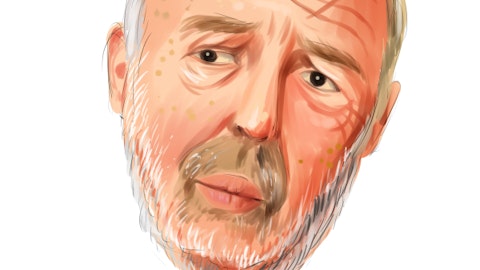Vertex Pharmaceuticals Incorporated (NASDAQ:VRTX) Q4 2022 Earnings Call Transcript February 7, 2023
Operator: Good day, and welcome to the Vertex Pharmaceuticals Fourth Quarter and Full Year 2022 Conference Call. All participants will be in a listen-only mode. After today’s presentation, there will be an opportunity to ask questions. Please note, this event is being recorded. I would now like to turn the conference over to Ms. Susie Lisa, please go ahead.
Susie Lisa: Good evening, everyone. My name is Susie Lisa and as the Senior Vice President of Investor Relations for Vertex, it is my pleasure to welcome you to our fourth quarter and full year 2022 financial results conference call. On tonight’s call making prepared remarks, we have Dr. Reshma Kewalramani, Vertex’s CEO and President; Stuart Arbuckle, Chief Operating Officer, and Charlie Wagner, Chief Financial Officer. We recommend that you access the webcast slides as you listen to this call. The call is being recorded and a replay will be available on our website. We will make forward-looking statements on this call that are subject to the risks and uncertainties discussed in detail in today’s press release and in our filings with the Securities and Exchange Commission.
These statements, including, without limitation, those regarding Vertex’s marketed cystic fibrosis medicines, our pipeline and Vertex’s future financial performance are based on management’s current assumptions. Actual outcomes and events could differ materially. I would also note that select financial results and guidance that we will review on the call this evening are presented on a non-GAAP basis. In addition, the impact of a foreign exchange is presented inclusive of our foreign exchange risk management program. I will now turn the call over to Reshma.
Reshma Kewalramani: Thanks, Susie. Good evening all and thank you for joining us on the call today. We are pleased to have closed out a strong 2022 with full year global CF product revenue up 18% versus 2021. Our full year 2023 product revenue guidance is $9.55 billion to $9.7 billion, representing 7% to 9% growth year-on-year inclusive of FX headwind of approximately 1.5%. We have more than 20,000 patients still to reach with CFTR modulators and we continue to work with focus and urgency to reach all patients with CF around the globe who may benefit from our therapies. It is an exciting time for Vertex. Our medicines have transformed CF and the growth of our CF business has transformed Vertex. Our differentiated R&D approach led to our multiple life-changing therapies in cystic fibrosis and is designed to deliver transformative medicines for serious diseases at high rates of success.
Agnostic to modality, it is delivering just that. In aggregate, our mid and late-stage clinical pipeline holds the promise to deliver potentially transformative benefit for patients across eight disease areas. As detailed on Slide 5, each program holds the potential to be best-in-class and transform the disease and each represents a multi-billion dollar market opportunity. Furthermore, we see the opportunity to launch new products into five of these disease areas within the next five years or our five and five goal and we’re not done. The next wave of innovation is also making progress and advancing through preclinical development, including programs in Duchenne’s muscular dystrophy and myotonic dystrophy Type 1. This breadth of pipeline success, accelerated pace of clinical trial progress and build out of commercial capabilities for upcoming product launches warrant continued investments in 2023.
As such, we are strategically investing and focusing on execution to drive forward the significant opportunity with a uniquely strong and durable CF franchise, a deep, broad and advancing R&D pipeline with multiple potentially near-term commercial opportunities, a strong balance sheet and a deeply talented and committed team, Vertex is well positioned to deliver for patients and shareholders for years to come. With that overview, I’ll turn to the details of recent R&D progress. Starting with CF. We’ll continue our journey in cystic fibrosis as we serially innovate to bring highly efficacious therapies to all CF patients. Our next in class vanzacaftor triple combination completed enrollment in its two Phase 3 clinical trials, SKYLINE 102 and SKYLINE 103 in patients ages 12 years and older in Q4 of 2022.
While TRIKAFTA sets a very high bar, our enthusiasm for this vanzacaftor program is also high. This program could deliver even greater benefits to patients given one, our highly predictive, in vitro human bronchial epithelial or HPE cell assays showed the vanza triple was superior to TRIKAFTA in improving chloride transport, a direct measure of CFTR function. Two, our Phase 2 clinical data also suggest the potential for greater efficacy for vanzacaftor versus TRIKAFTA. And three, the vanzacaftor triple also has the benefit of once-daily oral dosing and a substantially reduced royalty burden relative to TRIKAFTA. The Phase 3 trial are currently in the 52 week dosing period and we anticipate their completion towards the end of this year. Another important program is the VX-522 program, our CFTR mRNA approach that we are developing in partnership with Moderna for CF patients who cannot benefit from our CFTR modulators.
In December of 2022, the FDA cleared the IND for VX-522 and the single ascending dose study in CF patients was initiated last year, a major milestone for Vertex and the field. We have high expectations given over five years of research that led to the discovery of VX-522 with the following properties, one, delivery of mRNA at high efficiency into HBE cells; two, expression of CFTR protein leading to high levels of chloride transport; and three, in both rodents and non-human primates expression of CFTR protein in the desired cells; and lastly, a preclinical safety profile that supported advancement into human clinical trials. We are excited with the progress of VX-522, which brings hope to the more than 5,000 CF patients who are still waiting for a treatment that targets the underlying cause of their disease.
Turning now to exa-cel, our gene-editing program for severe sickle cell disease and transfusion dependent beta thalassemia. This is our most advanced program outside of CF and we expect exa-cel to be our next commercial launch. In late Q4, we completed our regulatory submissions for exa-cel for both sickle cell disease and beta thalassemia in the EU and UK. Both the EMA and the MHRA have recently validated the MAA submissions. And in the U.S., we remain on track to complete our rolling BLA submission by the end of this quarter. The remarkable clinical benefits are evident in the data we’ve shared to date. Exa-cel holds the promise to be the first CRISPR-based gene-editing treatment to be approved and represents a near-term and significant market opportunity, which Stuart will detail.
Turning next to VX-548 and our pain program. VX-548 is our novel selective NaV1.8 inhibitor that holds a promise of highly effective pain relief without the side effects or addictive potential of opioids. If approved, VX-548 would represent the first new class of pain medicine in decades with the potential to address the staggeringly high unmet need in acute pain. VX-548 acts on the peripheral nerves to block the pain signal and thus may be able to provide effective pain relief without the abuse potential, which is a central nervous system phenomenon. We have high expectations for this program because NaV1.8 is a genetically and pharmacologically validated target. Second, we have multiple positive proof of concept results with VX-150, a predecessor molecule to VX-548 and proof of concept with VX-548 itself.
And lastly, our Phase 3 program in acute pain is substantially similar to the positive Phase 2 trials we have already conducted. VX-548 has been granted Fast Track and Breakthrough Therapy designation in the U.S. We initiated pivotal development last year and we are enrolling patients across three Phase 3 studies with the goal of seeking a broad moderate to severe acute pain label. We anticipate completing the Phase 3 pivotal program towards the end of this year or the beginning of next, creating another potentially significant and near-term commercial opportunity, which Stuart will also discuss. In addition to validation of NaV1.8 as a target in acute pain, it has also been validated as a target in neuropathic pain. I am pleased to share that in late Q4, we initiated a 12-week Phase 2 dose ranging proof of concept study for VX-548 in peripheral neuropathic pain.
We look forward to updating you as this Phase 2 program progresses and to sharing more on the market opportunity on future calls. Transitioning now to inaxaplin or VX-147, the first potential medicine to target the underlying cause of APOL1-mediated kidney disease or AMKD, post the positive Phase 2 proof of concept study, inaxaplin is now being studied in a single adaptive Phase 2/3 pivotal trial. This study has a pre-planned interim analysis at 48 weeks of treatment, which if positive could serve as the basis to seek accelerated approval in the U.S. Our goal is to complete the Phase 2 dose ranging portion of the Phase 2/3 pivotal study this year, select a dose, and then continue on to the Phase 3 portion. We are also working to increase awareness screening and diagnosis through multiple initiatives given the high unmet need and the approximately 100,000 patients in the U.S. and Europe alone.
With inaxaplin, we see the potential of bringing a first-in-class treatment to patients with AMKD and unlocking a multi-billion dollar market opportunity. Moving to type 1 diabetes where a goal is to deliver a transformative if not curative therapy for the more than 2.5 million patients with type 1 diabetes in North America and Europe. We are advancing multiple programs. First, VX-880 is our stem cell-derived, fully differentiated, insulin-producing islet cells, which use standard immunosuppressive to protect the cells from the immune system. These cells are also foundational for the other two T1D programs. For VX-880, we achieved proof-of-concept last year with the first two patients treated in Part A of the VX-880 study. We have now fully enrolled Part B, where patients will receive the target dose on a staggered basis.
The next phase is Part C, expected to initiate later this year in which patients will be treated concurrently with the target dose. We look forward to sharing VX-880 data from more patients and with longer duration of follow up at medical congresses this year. Second VX-264 or the cells plus device, which encapsulates the same fully differentiated insulin producing islet cells in a proprietary device that shields the cells from the body’s immune system and hence there is no requirement for immunosuppressants. In late Q4, we simultaneously filed a CTA in Canada as well as the IND in the U.S. As we shared last month, the CTA has cleared and we look forward to initiating enrollment and dosing of patients in Canada in the coming months. In the U.S., the IND has not cleared.
We have received and responded to the FDA’s questions. We look forward to working with the agency with urgency, so that we can initiate the study in the U.S. as soon as possible. Third, in our hypoimmune program, we are editing the same fully differentiated insulin producing islets to cloak them from the immune system, another path to obviating the need for immunosuppressive. This program continues to progress in preclinical development. Let me close the T1D section with an update on the ViaCyte acquisition through which we gained intellectual property, tools and capabilities that hold the potential to accelerate our goal of developing transformative treatments for this disease. We have now completed our data and portfolio review and are very pleased with the progress to date.
We have begun executing our integration plans. On the clinical side, a Phase 1/2 study of VCTX-211, a hypoimmune cell program that originated with ViaCyte and that Vertex is now developing in partnership with CRISPR Therapeutics has been initiated and is ongoing. All other ViaCyte clinical trials have completed enrollment and dosing and are in the follow-up stage. I’ll finish up with the alpha-1 antitrypsin deficiency or AATD program. Both a Phase 1 study of VX-634, the first in a series of next wave AAT correctors and a 48-week Phase 2 study of VX-864, our first generation AAT corrector are ongoing. We look forward to updating you as these programs advance. I’ll now ask Stuart to review our commercial progress.
Stuart Arbuckle: Thanks, Reshma. Today, I will review our continued strong performance and outlook in CF as well as potential near-term commercial launches in new disease areas with exa-cel and VX-548. Starting with CF, where we continue to bring our transformative medicines to many more patients globally. Last month, we raised our estimate for the number of patients with cystic fibrosis in the U.S., Europe, Australia, and Canada to 88,000 up from our previous estimate of 83,000. The growth in the CF population can be attributed to more patients coming forward to receive treatment, better data capture in patient registries, and perhaps most importantly, people with CF are living longer due to improvements in patient care and the availability of truly effective therapies.

Photo by Julia Zolotova on Unsplash
For a baby born with CF in 2021, the Cystic Fibrosis Foundation predicts the median age of survival is now 65 years. In the U.S., our focus remains on maintaining the very high persistence and compliance rates we have seen with our therapies and extending the benefits into younger age groups. Outside the U.S., uptake of KAFTRIO/TRIKAFTA in countries with recent reimbursement agreements continues to drive growth, as has the rollout of KAFTRIO in children ages six to 11 years in countries where this indication has recently received reimbursed access such as France and Spain. There are still more than 20,000 CF patients who could benefit from, but are not on CFTR modulator treatment. These patients fall primarily into two categories. One, patients in countries where we are early on the launch curve, and two, younger patients for whom we continue to pursue additional label and reimbursement extensions, such as the recent U.S. approval of ORKAMBI for ages one to two years and recent regulatory submissions for KALYDECO in children ages one to four months, and for TRIKAFTA in ages two to five years, which has received Priority Review and a PDUFA date of April 28 in the U.S. We are confident that we will reach the vast majority of these patients over time, which will continue to drive revenue growth in the near and long-term.
We also see exciting growth potential for our vanzacaftor triple combo given the anticipated clinical profile, more convenient once daily dosing, and the potential to offer a new option for patients who have discontinued prior CFTR modulator therapy. Finally, in CF, as Reshma mentioned, our CFTR mRNA program VX-522 is being developed for the more than 5,000 CF patients worldwide who currently do not have any therapies that treat the underlying cause of their disease. I will now detail our commercial readiness efforts and the market opportunity for two potential product launches outside of CF, exa-cel and VX-548. Exa-cel holds curative potential for patients with sickle cell disease and transfusion-dependent beta thalassemia, and we are making significant progress with launch preparation activities.
Our initial launch of exa-cel will focus on the approximately 32,000 individuals in the U.S. and Europe for whom these diseases are most severe, presenting a significant clinical, humanistic and economic burden. The estimated 25,000 severe sickle cell disease patients have multiple hospitalizations annually for vaso-occlusive crisis, while the estimated 7,000 TDT patients undergo near monthly transfusions. There is also a considerable financial burden both for these patients and to the healthcare system. In the U.S. economic models project the lifetime treatment costs for severe sickle cell disease patients to be between $4 million and $6 million. Recent market research indicates that physicians have a strong preference and interest in gene editing over other potentially curative approaches.
And that patients with sickle cell disease are increasingly optimistic about the potential role for curative therapies in the treatment of their disease. In addition, payors view the emerging clinical data for exa-cel as highly impactful, most notably the reductions in vaso-occlusive crisis and hospitalizations. Importantly for our specialty commercial model, these 32,000 severe patients are concentrated geographically and we believe can be served effectively with a network of approximately 50 authorized treatment centers or ATCs in the U.S. and approximately 25 in Europe. We have established the needed supply chain and manufacturing infrastructure to support the launch, including validated chain of identity and chain of custody systems, global shipping infrastructure, and the needed manufacturing capacity to support uptake following approval.
And finally, we continue to work with key commercial and government payors and policy makers in the U.S. and Europe to ensure they understand the significant burden of these diseases and that broad patient access and reimbursement are in place if and when exa-cel is approved. To date, we have engaged with all U.S. state Medicaid agencies, some 150 unique U.S. commercial payors, as well as multiple health technology assessment bodies in Europe, including NICE and GBA, to share important information about exa-cel and our commitment to working collaboratively to provide access to this therapy. Shifting now to VX-548, which we believe has the potential to play an important role across the pain spectrum, including acute pain and chronic pain conditions.
I’ll focus my comments on acute pain, which is a near-term commercial opportunity. There are four aspects critical to framing the acute pain opportunity for Vertex. One, there is a significant unmet need due to the limitations and drawbacks of currently available treatments. Two, the market is large today, even with 90% generic prescribing. Three, prescribing is concentrated in the hospital setting and thus addressable with a specialty commercial infrastructure. And four, there is broad stakeholder recognition of the need for new therapies, which also helps provide a clear path to future patient access and reimbursement. Firstly, millions in the U.S. suffer from acute pain each year, yet it is often difficult to manage effectively given the limitations of existing therapies.
The current standards of care are NSAIDs and acetaminophen at one end of the spectrum, which are non-addicting, but offer limited pain relief and can pose GI and liver toxicity concerns. And at the other end of the spectrum are opioids, which provide effective pain relief, but have many undesirable side effects, including nausea and somnolence and have significant abuse potential. Many large hospital systems and all 50 states have adopted restrictions for the use of opioids. This leaves a vast gap in the treatment landscape for a medicine like VX-548 with strong efficacy, a desirable benefit risk profile, and without abuse potential given it is peripherally acting. Second, the acute pain market is very large valued in the U.S. at $4 billion, despite 90% of prescriptions being generic.
Third, this highly concentrated market can be served with a specialty commercial model. Of the 1.5 billion treatment days for acute pain annually, some two-thirds or 1 billion are driven by hospital prescribing, following inpatient or outpatient procedures such as surgeries or emergency room visits. Furthermore, these hospital-driven prescriptions are concentrated among approximately 1,700 hospitals that aggregate to roughly 220 integrated delivery networks. Thus, we believe we can reach a large proportion of this market with a specialty sales and marketing infrastructure and have begun to hire for key positions. Fourth, and finally, given the wide stakeholder recognition of the limitations of current treatments and the unmet need, we see both high demand and a clear path to access and reimbursement for a medicine with a profile like VX-548.
A key example of the path to reimbursement and access is the recently passed NOPAIN or Non-Opioids Prevent Addiction in the Nation Act signed into law last December. Through the NOPAIN Act, Congress has directed CMS to make a separate add-on payment to hospitals in the outpatient and ambulatory surgery center setting for non-opioids for the treatment of pain. We believe this new law is an important sign of the growing movement to remove barriers for hospitals, providers and patients to utilize non-opioid treatment options. In closing, we are excited about the opportunity to extend the benefits of our CF medicines to more patients around the globe and the near-term potential to commercialize transformative treatments for patients with sickle cell disease, beta thalassemia and acute pain.
I will now turn the call to Charlie to review the financials.
Charlie Wagner: Thanks, Stuart. Vertex’s fourth quarter and full year 2022 results represent another year of strong execution and exceptional financial performance. Fourth quarter 2022 revenue increased 11% year-over-year to 2.3 billion. Growth was led by a 24% year-over-year increase outside the U.S. on continued strong uptake of TRIKAFTA/KAFTRIO in markets with recently achieved reimbursement as well as label extensions into younger age groups. U.S. CF revenue grew 5% year-over-year with ongoing consistent performance. Full year 2022 revenue of 8.93 billion represents 18% growth versus 2021, marking Vertex’s eighth consecutive year of at least double digit revenue growth. Full year 2022 international revenue of 3.23 billion, increased 41%.
And full year U.S. revenue of 5.7 billion, increased 8% compared to 2021. For the full year 2022, we estimate the changes in foreign exchange negatively impacted our global revenue growth rate by approximately 1.5 percentage points inclusive of our foreign exchange risk management program. Fourth quarter 2022, combined non-GAAP R&D acquired IP R&D and SG&A expenses were 872 million, an increase of 5% compared to the fourth quarter of 2021. Full year 2022 combined non-GAAP R&D, acquired IP R&D and SG&A expenses were 3.07 billion, a decrease of 11% versus the prior year. Recall that 2021 results were impacted by 1.1 billion of acquired IP R&D charges, including the one time $900 million payment to CRISPR compared to 116 million of such charges in 2022.
Acquired IP R&D aside throughout 2022, we continued to invest in research and our advancing pipeline, which includes mid and late stage clinical assets across eight different disease areas. The year-over-year increase in spending reflects stepped up investments in programs where we made notable clinical progress, particularly in pain, the new vanza triple as well as type 1 diabetes. We also continued to invest in the pre-commercial buildout activities for exa-cel and preparation for other potential near-term launches. Given these programs potentially transformative benefit to patients and multi-billion dollar market opportunities, we will continue to invest accordingly. Fourth quarter 2022 non-GAAP operating margin was 50% and we generated non-GAAP operating income of 1.15 billion in the quarter, an increase of 15% versus the prior year period.
Full year 2022 non-GAAP operating margin was 54% and full year non-GAAP operating income was 4.79 billion, up 48% versus 2021. We ended the quarter with 10.8 billion in cash in investments as our cash flow generation and balance sheet remained very strong. On the business development front in Q4, we announced a global collaboration with Entrada Therapeutics focused on therapeutics for DM1. The HSR period expired last night and the transaction is expected to close within days. As a result, our Q1 2023 results are anticipated to include an approximate 224 million upfront payment recorded in our income statement and an approximate 26 million equity investment recorded on the balance sheet. Now switching to guidance. We are establishing 2023 product revenue guidance of 9.55 billion to 9.7 billion, representing 7% to 9% year-over-year growth at current exchange rates.
Note that this guidance includes an expected approximate 1.5 percentage point headwind to our revenue growth inclusive of our foreign exchange risk management program. Also note that 2023 product revenue guidance reflects revenue from cystic fibrosis products only. Exa-cel is not included in guidance as potential approval and launch dates in the EU, UK and U.S. are still to be determined. For our CF franchise in 2023, we see continued strong performance of TRIKAFTA/KAFTRIO in all major markets, further uptake in markets with recent reimbursement agreements and expansion into younger patient populations. Of note, with four years of TRIKAFTA experience, the majority of international reimbursement agreements secured and recent revisions in epidemiology, we have strong visibility to our 2023 revenue guidance range and another year of attractive growth for our CF product portfolio.
We are also providing 2023 guidance for combined non-GAAP R&D, acquired IP R&D and SG&A expenses in a range of 3.9 to 4 billion, which includes approximately 300 million of upfronts and milestones from known collaborations, including the expected upfront payment in Q1 2023 for Entrada. This targeted investment increase is consistent with the significant continued progress of our multiple mid and late stage clinical development programs and the expansion of our commercial and manufacturing capabilities in anticipation of the multi-billion dollar market opportunities represented by our programs with near-term launch potential. Our guidance for projected full year 2023 non-GAAP effective tax rate is a range of 21% to 22%. Lastly, we announced today a new $3 billion multi-year share repurchase authorization.
In closing, Vertex performed exceptionally well in 2022. We grew revenue double digits for the eighth consecutive year, maintained our strong balance sheet, invested internally and externally and accelerated programs across our diverse pipeline. In 2023, we look forward to further important milestones as highlighted on this slide to mark our continued progress in multiple disease areas. We look forward to updating you on future calls, and I’ll ask Susie to begin the Q&A period.
See also Dividend Challengers List Ranked By Yield and 25 Most Viewed YouTube Videos of All Time.
Q&A Session
Follow Vertex Pharmaceuticals Inc / Ma (NASDAQ:VRTX)
Follow Vertex Pharmaceuticals Inc / Ma (NASDAQ:VRTX)
Operator: We will now begin the question-and-answer session. And the first question will come from Salveen Richter with Goldman Sachs. Please go ahead.
Salveen Richter: Good afternoon. Thanks for taking my question. Can you frame what we’re going to see from the VX-880 program this year and when, and also on the second program, the cells and device program, how you overcome challenges here in your confidence level that you’ll be able to kind of get to the bars that you want to see?
Reshma Kewalramani: Yes. Hey, thanks for the question Salveen. With regard to the 880 program, remember, this is the program that is, let’s call it the naked cell program that requires off-the-shelf immunosuppressives. This is the program that we demonstrate proof of concept with the half dose patients last year. Where we are now is we fully enrolled this Part B, that’s where patients receive the target dose, but in a staggered manner. And the real importance here is and our excitement is to get to Part C because then we can dose patients concurrently. You should expect data this year at congresses. And there are a couple of important diabetes congresses that occur each year that will have longer duration of follow-up and more patients worth of data.
And the dimensions on which you can expect us to share information are what we’ve already done with the first two patients. That’s to say C-peptide levels decreases in exogenous insulin, improvements in hemoglobin A1C. With regard to the cells and device program, historically in the field, the challenge with devices has been fibrosis, lack of oxygen getting to the cells inside these devices, as well as the inability for nutrients to go in and for insulin in this instance to be secreted out. We have worked long and hard to develop a proprietary, what we call a channel array device. This device has particular features in terms of geometry, materials and proximity of blood and oxygen to ourselves to overcome these historic barriers. And what I’ll say to just give you a little bit more on this point is in small animal models and large with our proprietary device, we have seen no evidence of fibrosis.
Last thing to point out, of course, the same 880 cells that we’ve already shown proof of concept with, those are the same cells in the cells plus device presentation as well as in our hypoimmune presentation.
Salveen Richter: Thank you.
Operator: The next question will come from Geoff Meacham with Bank of America. Please go ahead.
Geoff Meacham: Hey, everyone, afternoon and thanks for the question. Just have two for VX-548 is the communication strategy here to have all the Phase 3 data in acute pain and neuropathic pain and then disclose everything before filing? I wasn’t sure what the plan was there? And then Stuart, given the hospital setting, what role do you think that treatment algorithms and cost benefit studies will play commercially? This is obviously a pretty different market than you guys are typically used to. And then for 522, I don’t have a doubt that you guys can express CFTR, but obviously has to be in the right tissues. Can you talk maybe about the technical challenges here with an mRNA strategy and your development plans and just at a high level? Thank you.





